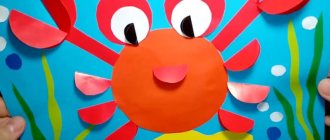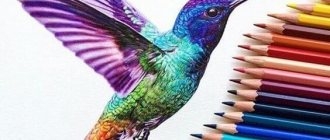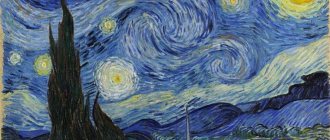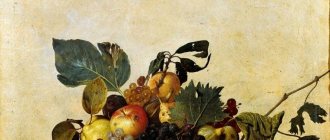At what age should a child be introduced to such a concept as genres of painting in the fine arts? Researchers and scientists from many countries around the world have identified types of fine art and genres of painting for preschool children, and in accordance with this, methods for mastering art have been determined.
About 40-50 years ago in our country, reproductions of paintings by Russian artists hung in almost every house. I remember admiring them as a child and changing places. The most interesting thing is that in the houses of all our friends, all the walls were decorated with similar reproductions. It was such a simple and unobtrusive way that children became acquainted with the wonderful creations of artists. When I became a mother, I also tried to introduce my children to art.
Genres of painting for children 2-3 years old
A child’s acquaintance with art should begin at the age of 2-3 years. At this age, three genres are appropriate: landscape, portrait, still life. You should not explain to your child the meaning of the painting and talk about the artist’s biography. It is necessary to create a cultural space around the child to cultivate good taste.
In the children's room you can organize a small home exhibition (reproductions of paintings by Vasnetsov, Perov, Aivazovsky, Shishkin...), which will be gradually updated and expanded. Parents need to learn to capture children's emotions that the picture evokes. The baby notices beauty, perceives it and receives joy when it comes into contact with it. This is how a child’s first interaction with art occurs.
The French writer Françoise Barbe-Galle gives in her book “How to Talk to Children about Art” an exact comparison of this emotional contact with art: “We can admire a flower without being able to read its Latin name and generally having no idea what it is called.”
For a two-year-old child, a painting is the most interesting object of study. Examine and describe with him what is depicted on it, study the colors, search for objects...
Parents should pay attention to the baby’s reaction and select for viewing those reproductions that will be of interest to him.
In the process of communication, the mother draws the son’s (daughter’s) attention to the reproduction of the painting: “Look out the window. How green the trees are in our yard! They are very tall! And what beautiful trees are depicted in this picture! This is a forest. In the forest you can hear birds singing..." (reproduction of I. I. Shishkin’s painting “Forest”) or
S. Rodionova “Still life with apples”
“Help me put apples in a vase! They are so red, just like in the painting. Look at the picture! Do you like apples? (reproduction of Svetlana Rodionova’s painting “Still Life with Apples”) or “What a handsome boy! His name is Mika. What is he doing? Sits on a chair. His cheeks are pink! Curly hair! The eyes are big! Where is he looking? Maybe he saw a little titmouse outside the window? (reproduction of V. A. Serov’s painting “Mika Morozov”).”
V. A. Serov “Mika Morozov”
When studying the primary colors in painting (red, yellow, blue), you can use reproductions of paintings from different genres where these colors dominate.
This you need to know:
It is very important to observe the measure in the number of reproductions.
For children's perception, it is best to choose large format reproductions (A4, A3) with large contrasting images.
All work should be located at the child’s eye level.
Series “Super Stickers Art” from the publishing house “Makhaon”
Several books were published in the series, including:
- Davis Courtauld "Tales of Pictures"
- Davis Courtauld "Stories about Artists".
It is better to start forming a culture in children from a very early age, and these books will be of great help here.
- The highlight of the edition is stickers with images of world masterpieces.
- The paintings are arranged according to themes: animals, clothing and fashion, self-portraits, entertainment, city life.
- Fascinating facts from the life of artists, as well as interesting stories about the creation of paintings.
- More than 100 famous paintings!
Age limit: due to the stickers, the books will be of interest to children aged 3-4 years and older. Features of the publication: 32 pages, coated paper, disposable stickers.
What is a genre of fine art?
The French word "genre" is translated as "genus", "species".
An artist may give preference to one genre or one type of fine art, or he can work successfully in different genres and in different types of fine art (painting and sculpture, painting and graphics...)
Usually the artist is called by the genre that is the main one in his work (battle painter, animal painter, portrait painter, landscape painter...)
All works of fine art are divided into genres that can merge (the Monument to Minin and Pozharsky can be classified as a portrait and a historical genre) and branch out (I.K. Aivazovsky wrote marinas (seascapes) and battles (sea battles). The battle genre can be classified as "branches" of the historical genre).
Susie Hodge “Why are there so many naked people in art? And other important questions about art"
Are statues ugly? Why do we need fruit? Why is everything so blurry?
Susie Hodge's book answers these and other questions (possibly arising from museum visitors), while introducing the reader to genres, themes and styles of art.
- The trick is the unusual “magazine” design of the book. Various fonts, callouts, and hand-drawn borders of illustrations attract attention and prevent boredom.
- Just something complicated. They talk, for example, about abstract art or the art of Ancient Egypt with a sense of humor and clear language.
- Non-trivial information.
Age limit: for children from 6 years old and everyone who is just beginning to comprehend art.
Features of the publication: 96 pages, offset printing.
How to introduce a preschooler to still life?
Still life is a genre of fine art dedicated to the depiction of things surrounding a person: household items, tools, flowers, food (bread, fish, fruits, vegetables...), books, musical instruments, etc.
Home themed exhibitions in the still life genre can be devoted to the following topics: “Bread”, “Flowers”, “Fruits and Vegetables”, “Household Items”.
Such famous artists as I. T. Khrutsky, I. E. Grabar, K. S. Petrov-Vodkin, V. F. Stozharov, K. A Korovin and others worked in the still life genre.
There are two types of still life in fine art.
In one form, things seem to characterize their owner, talking about his position in society, profession, hobbies. It feels like the owner of the things has left and is about to return. For example, the painting “Morning Still Life” by K. S. Petrov-Vodkin.
K. S. Petrov-Vodkin “Morning still life”
In the second type of still life, things are depicted by the artist in order to impress the viewer with their beauty, their color, their shape... For example, the still life of V. F. Stozharov “Bread, salt and brother.”
V. F. Stozharov “Bread, salt and brothers”
When telling your son (daughter) about a still life, you should note:
- Title, author (What is the name of the painting? Who painted it?);
- Content, composition (What do we see?);
- era (when did people use such utensils (such objects)?);
- the artist’s writing style (favorite colors, large strokes...);
- main idea (what is the artist talking about in his painting?)
A story about a still life should be emotional in order to attract the child’s attention:
“What do we eat every day? Bread. And what is it like? How should you treat bread? Look at this picture. It's called "Bread, Salt and Bro." It was painted by the artist V.F. Stozharov. He placed bread in the center of the picture. His bread is tall, round, golden, appetizing... Next to him lie large chunks of a cut loaf. The bread lies on a snow-white embroidered towel. The golden brother and the embroidered towel on the red canvas tell us that bread is the main value on earth.
Bratina – spherical vessel of the 16th-17th centuries. for drinking at brotherly feasts, “for all the brethren.”
The still life is depicted against the background of a log wall illuminated by the sun. The colors chosen by the artist evoke joy and reverence for the bread. The painting by V. F. Stozharov reminds us of a careful attitude towards bread.”
“This still life is called ... . It was written by... It evokes joy and admiration. There is carnation, chamomile, peony... I want to reach out and take such a lush bouquet in my hands to inhale its aroma. What would you call this painting? Who do you think could have collected the bouquet? Maybe it was given to my mother? Did you like the bouquet? What mood does this bouquet make you feel? In what mood do you think the artist painted this picture? What colors did the artist use to convey his mood? Please think about why the artist decided to paint this bouquet?”
While viewing the paintings, you need to pay attention to how bread (flowers, fruits...) was depicted by different artists. In Mashkov’s painting “Moscow Food” the table is full of loaves and loaves, in Petrov-Vodkin’s painting “Herring” there is only one piece of black bread on the table, in Fedotov’s painting “Aristocrat’s Breakfast” the bread can only be noticed if you look very closely at the plot , in Serebryakova’s painting “Lunch” we see bread in the field at the collective farmers’ lunch. What kind of bread looks appetizing (seems warm, I want to try it)?
How to introduce a preschooler to a portrait?
Portrait (from the French word portrait - image) is a genre of fine art dedicated to the depiction of a person or group of people.
Portraits are part of history. They contain images of people from different eras. From the portraits we can understand what kind of world the artist lived in and how he treated people.
The person in the portrait can be drawn in full height, chest-deep (chest-length), waist-deep (waist-length), knee-deep (knee-deep).
According to the rotation of the head, portraits can be: profile, full face (French en face - “from the face”), a quarter turn to the right or left, three quarters, half a turn.
According to the method of execution, a portrait is divided into pencil, pastel, oil, watercolor, engraved, photographic, etc.
According to the nature of the image, two groups are distinguished: ceremonial (an image of a person on a horse, standing at full height or sitting against the backdrop of landscape or architecture) and chamber portraits (a chest-length, half-length image of a person against a neutral background).
A portrait is called a costumed portrait if a person is depicted as a literary (theatrical, allegorical, historical, mythological) character. When naming such a portrait, include the words “in the image” or “in the form.”
A portrait can convey not only the individual features of a person, but also the characteristic features of the era in which the person being portrayed lived.
By the face, posture and gestures of the model, you can guess her behavioral characteristics, temperament and character.
By depicting a specific person, the portrait painter reflects the time, experiences, dreams of his compatriots, as well as his ideals and his attitude towards the model.
The work of famous artists is associated with the portrait genre: V. M. Vasnetsov, A. G. Venetsianov, V. A. Tropinin, K. E. Makovsky, K. P. Platonov, V. I. Surikov, A. A. Plastov, I. E. Repin, V. G. Perov, I. E. Grabar and others.
Children's portraits are close to the feelings of a preschool child. They evoke positive associations in them. Facial expressions and the placement of hands help the preschooler understand the mood, character, and spiritual world of the person being portrayed.
Sample conversation about a portrait:
Questions about the content of the painting: Who is depicted in this painting? What can you tell about him (her)? How old is he/she? What is his/her name? What is he doing? What is depicted next to him (her)? What do these objects tell about him (her)?
Questions that reveal a person’s emotional state and mood: what is the boy (girl) thinking about? What does he (she) see (hear)? What does he/she want to do? What do you see in his (her) eyes? What are they talking about? What does his clothing say? What mystery can be solved by looking at the hands of this boy (this girl)? Why did the artist depict him/her in this pose?
Based on leading questions, the child composes a descriptive story. An approximate story based on the portrait of V.A. Serov "Mika Morozov":
The painting shows a boy. He is 4 years old. His name is Mika. He sits on a big chair. There is a toy next to him. The boy put it aside because he saw a little titmouse outside the window. I see surprise in his eyes. He's about to jump off the high chair and run to the window to get a good look at the beautiful bird.
A story based on the portrait of I. E. Repin “Dragonfly”:
I. E. Repin “Dragonfly”
In this painting the artist depicted a girl. She is 5 years old. She sits on the fence with her legs dangling. The girl looks a lot like a dragonfly. She's not afraid of heights. She has a beautiful green dress. She rejoices in the sun, grass, sky.
During the conversation, you can ask the child to come up with his own name for the portrait, reveal a secret in the picture hidden by the artist, etc.
Jackie and Susie Klein "What is Contemporary Art? Guide for children"
Contemporary art is a complex topic and definitely deserves special discussion. Without knowledge about it, a child’s horizons will be incomplete.
This guide will tell you about some artists and their unusual works, and will allow you to look into the behind the scenes of painting.
- The trick is a lot of illustrations and comments that reveal the secrets of creating masterpieces.
- Encouraging dialogue with the reader. Questions that make you think and look at the pictures for a long time.
- Excellent print quality.
Age limit: for a wide range of readers. The book will really interest both children and many adults.
Features of the publication: 64 pages, coated paper.
Genre painting
Historical genre
The historical genre is a work of art that reflects historical events and depicts the heroes of the past. The historical genre often overlaps with the portrait, everyday life and battle genres.
To get acquainted with the historical genre, the works of V. M. Vasnetsov “After the massacre of Igor Svyatoslavovich with the Polovtsians”, K.P. Bryullov “The Last Day of Pompeii”, I. E. Repin “Barge Haulers on the Volga”, etc.
The most prominent representative of this genre in Russian painting is V.I. Surikov (“Menshikov in Berezovo”, “The Conquest of Siberia by Ermak”, “Suvorov’s Crossing of the Alps”, etc.).
V. I. Surikov “Menshikov in Berezovo”
Domestic
The everyday genre is paintings that depict the everyday life of people, their way of life.
The everyday genre can be introduced to a preschooler using the example of the paintings by P. A. Fedotov “Major’s Matchmaking”, “Breakfast of an Aristocrat” and A. G. Venetsianov (“Zakharka”, “On the Arable Land”, “The Barn”).
P. A. Fedotov “Major’s Matchmaking”
Battle
The battle genre - (from the French bataille - battle) - a genre of fine art dedicated to military life.
In the battle genre, the main place is occupied by military campaigns and battle scenes. The battle painter strives to show the most important moment of the battle, to convey the historical meaning of military battles, which brings the battle genre closer to the historical one. Scenes depicting military life connect the battle genre with the everyday genre.
You can introduce a preschooler to the battle genre through the works of the outstanding Russian battle painter V.V. Vereshchagin.
Animalistic
Animalism (from the Latin animal - animal) is a genre of fine art, the main motif of which is animals.
You can introduce your child to the animalistic genre from the books of the famous animalist E.I. Charushin (“About Tomka”, “Wolf and others”), who is both an author and an illustrator. It is important to explain to the child that an animal artist needs to observe the habits of animals for a long time in order to create their image and convey their character.
Drawing by E. I. Charushin
Many animalists endow their animals with human qualities. An example of this is Albrecht Dürer’s most famous watercolor “Young Hare” (1502). The portrait of this hare is similar to a portrait of a man.
Mythological
The mythological genre is a branch of the historical genre that tells about the plots of legends and legends.
The mythological genre can be studied from the drawings of I. Ya. Bilibin in “The Tale of Tsar Saltan”, in “The Tale of the Fisherman and the Fish”, in “The Tale of Ivan Tsarevich and the Gray Wolf”, in the fairy tale “The White Duck”, etc.
I. Ya. Bilibin. Illustration for the fairy tale “The Frog Princess”
The most famous mythological works include the works of M. A. Vrubel “Pan” and “The Swan Princess”.
V. M. Vasnetsov turned to fairy-tale-legendary themes in his work (“Alyonushka”, “Bogatyrs”, “The Frog Princess”, “The Serpent Gorynych”, etc.)
Mary Richard "Masterpiece! The Greatest Artists of All Time"
The encyclopedia talks about the manifestation and development of different types of art, introduces the main artistic movements, authors and their works.
- The trick is entertaining infographics that make reading easier.
- The uniform format of articles makes it easier to remember information, compare different directions and track their development.
- Develops memory, attention, interest in art, broadens the child’s horizons.
Age limit: 10+. Perfect for both children and adults.
Features of the publication: 96 pages, offset printing.
Ways to develop the perception of works of art
The idea of fine art genres is formed not only at exhibitions and excursions to museums, but also during games.
Perceiving works of art is an emotional and intellectual work that requires certain preparation from the child.
Due to the fact that a preschooler is just learning to “read” the three-dimensional space of a picture, he should develop his powers of observation and pay attention to beauty (the combination of colors, the shape of objects) during walks, hikes, excursions, games, etc. It is important to teach the child notice the beauty in living nature so that he can see the beauty in the picture.
A preschooler’s developed perception of works of art is manifested in the fact that he understands what is depicted in the picture and what the artist wanted to tell us.
To develop emotional perception, you can use the technique of “entering the picture”:
How do you feel looking at this picture? What mood does the artist convey to you? Let's imagine that we find ourselves in this forest (in this clearing, on this path, on this mountain...). Touch the tree (water, leaves)! How did you feel? What is it like? Walk through that foliage! Do you hear rustling? Touch the water (grass, leaves, etc.). Look at the sky! What is it like? Try to breathe some air into yourself! How did you feel? etc.
To develop artistic thinking, children should pay attention to expressive means: “With what colors did the artist convey joy to us (silence, peace, excitement, sadness, fear, freshness...)? How would you feel if he took dark colors?”
An attitude technique can express your emotional and personal attitude towards a painting. The preschooler is given the instruction to compose a mini-story based on the picture: “Before you say what you like about this picture and what you think about it, you need to remember what it is called, what it is dedicated to and what the artist wanted to convey to us.
Dick Bruna: Miffy in the Museum
It used to be that children in museums were bored and uninteresting, all “no”, “don’t touch with your hands”, “don’t make noise”... Fortunately, the situation is changing. Museum workers are trying to keep up with their Western colleagues and are adopting best practices in organizing exciting museum quests, interactive games, lectures, seminars and other “artistic and educational gadgets” that are gradually returning museums to their lost popularity among the younger generation.
Parents should also help their kids a little. The feeling of beauty is inherent in them from birth. There is a lot in common between an artist and a child. You just need to leave them alone more often...
Kids will find this book about Miffy interesting. Together with the little rabbit Miffy we will find ourselves in the museum. Why not explore different pieces of art?









